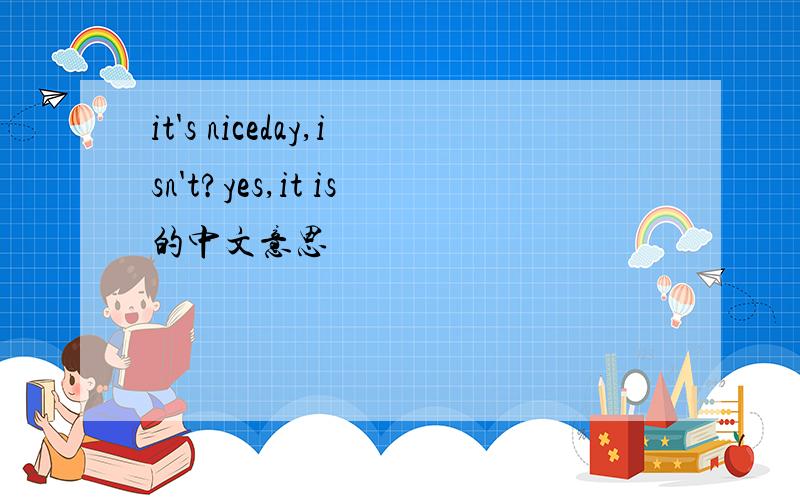it's niceday,isn't?yes,it is的中文意思
来源:学生作业帮助网 编辑:作业帮 时间:2024/11/28 12:17:00

it's niceday,isn't?yes,it is的中文意思
it's niceday,isn't?yes,it is的中文意思
it's niceday,isn't?yes,it is的中文意思
今天是个好天气,不是吗?对,是个好天气
今天天气真好,不是吗?是的,它是
反意疑问句又叫附加疑问句,是在陈述句后,对陈述句所叙述的事实提出的疑问。其基本结构有两种:一是“肯定陈述句+简略否定问句”;二是“否定陈述句+简略肯定问句”。反意疑问句的前后两部分在时态、人称和数上都要保持一致。
例如:
(1)It looks like rain, doesn’t it? 似乎要下雨了,不是吗?
(2)He doe...
全部展开
今天天气真好,不是吗?是的,它是
反意疑问句又叫附加疑问句,是在陈述句后,对陈述句所叙述的事实提出的疑问。其基本结构有两种:一是“肯定陈述句+简略否定问句”;二是“否定陈述句+简略肯定问句”。反意疑问句的前后两部分在时态、人称和数上都要保持一致。
例如:
(1)It looks like rain, doesn’t it? 似乎要下雨了,不是吗?
(2)He doesn’t need to work so late, does he? 他不必工作到那么晚,不是吗?
学习反意疑问句,特别要注意:
(1)陈述部分的主语是I,疑问部分要用aren’t I.
I’m as tall as your sister, aren’t I? 我和你妹妹一样高,不是吗?
(2)陈述部分的谓语是wish,疑问部分要用may+主语。
I wish to have a word with you, may I? 我希望和你谈谈,可以吗?
(3)陈述部分用no, nothing, nobody, never, few, seldom, hardly, little等否定含义的词时,疑问部分用肯定形式。
The Swede made no answer, did he / she?那个瑞典人没回答,是吗?
Some plants never blossom (开花),do they?一些植物从不开花,是吗?
(4)陈述部分有have to +v. (had to +v.),疑问部分常用don’t +主语(didn’t +主语)。
We have to get there at eight tomorrow, don’t we?我们明天8点得到那儿,是吗?
(5)陈述部分有must的疑问句,疑问部分根据实际情况而定。
He must be a doctor, isn’t he?他可能是一名医生,是吗?
You must have studied English for three years, haven’t you? / didn’t you?你一定学3年英语了,是吗?
He must have finished it yesterday, didn’t he?他很可能昨天就完成工作了,是吗?
(6)陈述部分由neither …nor, either…or连接的并列主语时,疑问部分根据其实际逻辑意义而定。
Neither you nor I am an engineer, are we?你和我都不是工程师,是吗?
(7)陈述部分主语是指示代词或不定代词everything,that,nothing,this,疑问部分主语用it。Everything is ready, isn’t it?每样东西都准备好了,是吗?
(8)陈述部分为主语从句或并列复合句,疑问部分有三种情况:
a. 并列复合句疑问部分,谓语动词根据邻近从句的谓语而定。
Mr. Smith had been to Beijing for several times, he should have been in China now, shouldn’t he?史密斯先生去过中国几次了,他现在应该已在中国,不是吗?
b. 带有定语从句,宾语从句的主从复合句,疑问部分谓语根据主句的谓语而定。例如:
1)He is not the man who gave us a talk, is he?他不是给我们演讲的那个人,是吗?
2)He said he wanted to visit Japan, didn’t he?他说他想要去日本参观,是吗?
c. 上述部分主句谓语是think,believe,expect,suppose等引导的宾语从句,疑问部分与宾语从句相对应构成反意疑问句。例如:
1)I don’t think he is bright, is he?我认为他不聪明,是吗?
2)We believe she can do it better, can’t she?我们相信她能干得更好,是吗?
(9)陈述部分主语是不定代词everybody, anyone, somebody, nobody, no one 等,疑问部分常用复数they,有时也用单数he。例如:
1)Everyone knows the answer, don’t they? (doesn’t he? )每个人都知道这个答案,是吗?
2)Nobody knows about it, do they? (does he? )没人知道这件事,是吗?
(10)省去主语的祈使句的反意疑问句,疑问部分用will you.
1)Don’t do that again, will you?别再那么干了,好吗?
2)Go with me, will you / won’t you?跟我一起去,好吗?
【注意】Let’s开头的祈使句,后用shall we?
Let us开头的祈使句,后用will you? 例如:
1)Let’s go and listen to the music, shall we?咱们去听音乐,好吗?
2)Let us wait for you in the reading-room, will you?让我们在阅览室等你,好吗?
(11)陈述部分是“there be”结构的,疑问部分用there省略主语代词。例如:
1)There is something wrong with your watch, isn’t there?你的手表坏了,是吗?
2)There will not be any trouble, will there?不会有任何麻烦,是吗?
(12)否定前缀不能视为否定词,其反意疑问句仍用否定形式。例如:
1)It is impossible, isn’t it?这不可能,不是吗?
2)He is not unkind to his classmates, is he?他对他的同学不刻薄,是吗?
(13)must在表“推测”时,根据其推测的情况来确定反意疑问句。例如:
(1)He must be there now, isn’t he?他可能在那儿是吗?
(2)It must be going to rain tomorrow, won’t it?明天可能要下雨,是吗?
收起
天不错呀!难道不是吗?
是的,不错。